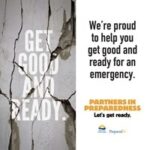Emergency Preparedness in Saskatchewan
Because Saskatchewan has similar land-features to Alberta (flat, prairies, wheat and canola fields, etc.), it also shares similar risks when it comes to commonly occurring natural disasters. The most prevalent are floods and landslides, wildfires and tornadoes; the very most common of these is floods.
If you would like a more general outline of how to get prepared for these kinds of emergencies, either in Alberta or Saskatchewan, please refer to our previous post Emergency Preparedness in Alberta. Here, we’ll be talking a little about the more specific risks inherent in flooding, and how to minimize these risks.
Before a Flood
As the most common natural hazard in Saskatchewan, floods can happen anytime there is heavy rainfall or a lot of melting snow. Some of the risks include drowning, getting caught in landslides or hit by dislodged materials, and electrocution. In order to prepare for a flood, you can…
- Put weather protection sealant around lower-level doors and windows. Products like Quick Dams are invaluable resources for absorbing and redirecting flooding waters.
- Install downspout drainage far away from your house, and, downhill if possible.
- Install a sump pump in your basement.
- Keep important documents, books, or other important items at a high level.
- Allow livestock a higher-ground place to which to escape.
If you know a flood is coming, it’s important to turn off your basement furnace and outdoor gas valve and keep electrical equipment at a high level. It’s also wise to bring any toxic materials above ground floor level to avoid pollution. In order to protect your home further by adding polyethylene barriers or sandbags, please contact your local emergency officials before proceeding.
In the Event of a Flood
- Be extremely cautious about the combination of water and electrical wires and avoid it by as large a margin as you can!
- Keep your radio on to find out the latest news on which places are safe and which places to avoid. Make sure you don’t miss out on directions from local emergency teams!
- And of course, keep your emergency kit close at hand, especially in case you need to leave your home. You might rest easier with one of our Outdoor Survival Kits. This way, you can add extra food if you’d like and escape to higher ground with all of the survival necessities already packed for you, and ready to go.
- Evacuate with extreme caution, and upon directions for emergency authorities. Take advised routes, avoiding shortcuts, bridges or flooded areas if possible, and letting loved ones know what is going on.
Once you have been told that it’s safe to return to your home, it’s still important to reenter with caution, and assess the damage for yourself as well, taking care to note any debris, water contamination or buckling walls or roofs. Get an electrician to inspect your main electrical panel, as well as any appliances that may have been flooded.
Clean aggressively and if you’re unsure of anything, it’s best to get it checked out! For more information on repair and cleanup procedures, check out this article.
Article contributed by Sophie Wooding – Avid gardener and cyclist in Victoria, BC and Content Writer for Frontier.io






